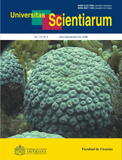Abstract
En el presente estudio se evaluó la capacidad probiótica in vitro de una cepa nativa de Saccharomyces cerevisiae (A) y se comparó con una cepa comercial (B) utilizada como probiótico. Para esto se determinó la concentración de melaza de caña (10, 20 y 30% (p/v)) que permitiera obtener la mayor cantidad de biomasa de las cepas, así mismo se determinaron parámetros cinéticos. La concentración de melaza que arrojó mejores resultados fue 20% (p/v) y se encontró diferencia en la producción de biomasa para la cepa en estudio A (28g/L) y la cepa control B (3g/L) en medio melaza. Se realizaron pruebas in vitro como resistencia a sales biliares, tolerancia a rangos de pH y jugos gástricos, donde no se observaron diferencias entre la cepa A y B al medir el crecimiento. La reducción del colesterol en presencia de sales biliares después de 12 horas de incubación fue de 54% para la cepa A y 58% para la B. Por último se realizó una prueba de adherencia en células Caco-2, encontrando adherencia a estas por parte de ambas cepas. De acuerdo con los resultados anteriores se demostró que la cepa A tiene propiedades probióticas in vitro que pueden ser corroboradas con posteriores estudios in vivo que confirmen su utilización como probiótico en nutrición animal.
Palabras clave: Adherencia, Biomasa, Melaza de caña, Probiótico, Saccharomyces, Tolerancia
Abstract
The in vitro probiotic capacity of a native strain of Saccharomyces cerevisiae (A) was evaluated and compared with a commercial strain (B) used as a probiotic. The effect of the concentration of sugarcane molasses (10, 20 and 30% (w/v)) on the biomass production was investigated and kinetic parameters were determined. The best molasses concentration was 20% (w/v) and differences in biomass production on molasses medium between strain A (28 g/L) and control strain B (3 g/L) were observed. In vitro tests such as tolerance to bile salts, pH and gastric juices were carried out, and no differences in growth between strain A and B were found. Cholesterol reduction on presence of bile salts after 12 hours of incubation was of 54% for strain A and 58% for strain B. Both strains showed adherence to Caco-2 cells. Results reveal that strain A possesses in vitro probiotic properties that can be verified with further in vivo studies to confirm its suitability as probiotic in animal nutrition.
Key words: Adherence, Biomass, Sugarcane molasses, Probiotic, Saccharomyces, Tolerance
Univ. Sci. is registered under a Creative Commons Attribution 4.0 International Public License. Thus, this work may be reproduced, distributed, and publicly shared in digital format, as long as the names of the authors and Pontificia Universidad Javeriana are acknowledged. Others are allowed to quote, adapt, transform, auto-archive, republish, and create based on this material, for any purpose (even commercial ones), provided the authorship is duly acknowledged, a link to the original work is provided, and it is specified if changes have been made. Pontificia Universidad Javeriana does not hold the rights of published works and the authors are solely responsible for the contents of their works; they keep the moral, intellectual, privacy, and publicity rights. Approving the intervention of the work (review, copy-editing, translation, layout) and the following outreach, are granted through an use license and not through an assignment of rights. This means the journal and Pontificia Universidad Javeriana cannot be held responsible for any ethical malpractice by the authors. As a consequence of the protection granted by the use license, the journal is not required to publish recantations or modify information already published, unless the errata stems from the editorial management process. Publishing contents in this journal does not generate royalties for contributors.



